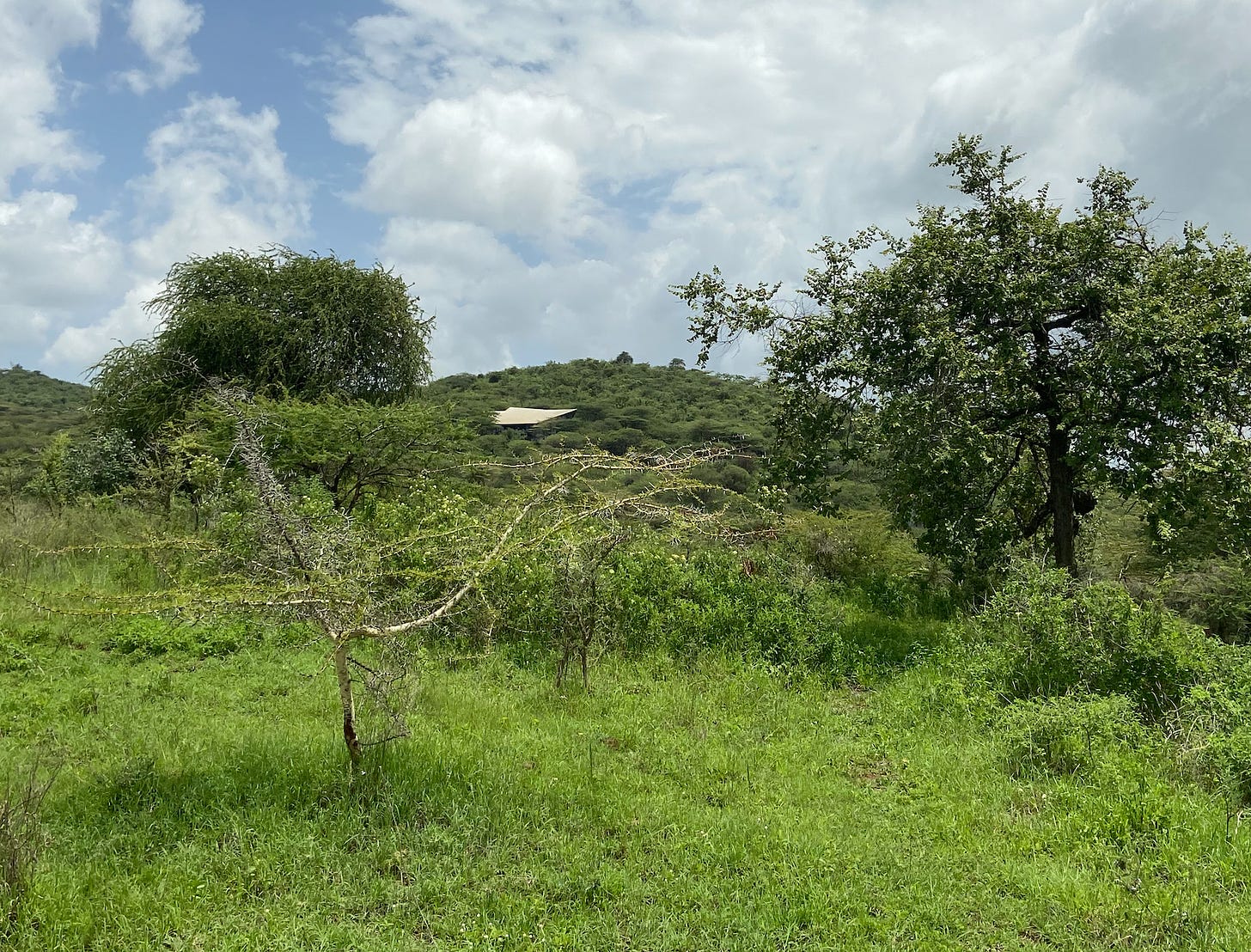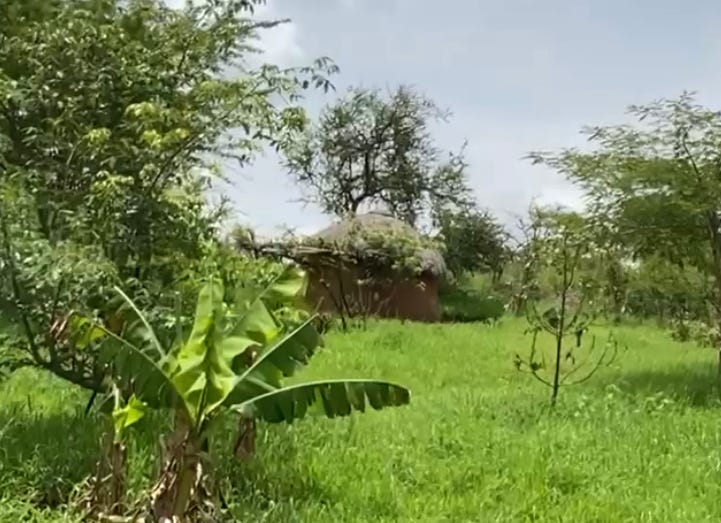I have been dreaming and talking with friends and family about the place we will build. A place of community and sharing. This will be a place of healing, retreat, and practice. But for now, this is the shamba, the farm, on Ngurobob hill.
It’s a year ago this week that we bought the land. In November, I went there again for a couple of weeks. I checked on the 120 fruit and nut trees we planted in March, and about 30 flowers and bushes, It’s 4 plus acres of land so that changed about 1/3rd of property, with the landscape changing from desert and farm to residence and orchard. And then 2000 pieces of Mchongoma planted along the fence line.
The land comes from the Massai, and their goats inhabit this area of Tanzania. And they will eat just about everything, including the roots of grasses, during the dry season. When I met the Massai chief, he said I could call him Kumandari. I asked others what this meant and was told: he has the most goats (the Kiswahili word might come from the Hindi word kumaanadaaree: the one in command). The Kumandari told me how much he hates fences, calling them evil! But I explained to him my intentions, and he acquiesced (besides, the fence came with the property). However, they don’t keep their goats from trying to get through the barbed wire fence constructed a decade ago, hence the mchongoma for added reinforcement.
The local Tanzanian or other tribal and Massai people know it sometimes as Goat or Dirt hill. The word Ngurobob is similar in sounding to Ngorongoro for the same reasons. Cows and their cowbells and the sound they’d make.
Of the three Maasi brothers, one had cows, the other had goats, and the other had a farm. The cows and goats roamed all over the hills of Ngurobob and still do on the other side of the hill.
Here is a photo of the land fifteen years ago. After 2/3rds of the land was already fenced in (the adjacent 1/3rd to the left is the farm-now-orchard):
You can see a line down the middle of the fenced-in plot in the above photo. The part to the left is where the orchard is now growing:
And here is one from February of this year during the rainy season:
And during the dry season:
Most of the land had been planted with Acaia fourteen years ago. However, Acacia roots are invasive and choke out other less hardy trees, so at the end of March, we chopped down 45 acacia trees on the land along the old fence line (about half remain to the right of the road) next to the new orchard, replacing them with non-invasive flowering trees (the neighbors were extremely pleased with the firewood).
The roots of the acacia trees will provide fertilizer and easier root growth for the new trees. When I was back there again in November, I focused on native trees, finding bush fruits and succulents. Another 100 trees were planted, along with 200 succulents throughout the property. And another 1000 Mchongoma along the fence.
Not much infrastructure has been built on the land yet. Part of the dream was always to plant the trees first and then arrive when they were in full production mode two to five years later. In April, we laid the water lines to the end of the property and built a dual-septic tank system with a french drain and a cistern to collect water. We built a shed out of cinder blocks in May. A twenty-foot container arrived from the States with plenty of tools in June.
Our caretakers and their children live directly across the road from us. Godfrey is his name, but everyone calls him ‘Godi.’ They are watching over and caring for the land as it grows. I am inspired by this place, this shamba, and how it has regenerated from a barren rocky hill to greenery to what will be a lush oasis pocket along the equator. I read an interesting story online (can’t find the link again) about Ngurobob hill.
An ex-pat woman who lived on the hill (around 20 such families reside on Ngurobob) was traversing by foot to one of the distant hills when they came upon an elder Massai, and this was their conversation.
‘Shikamoo’ (how one greets an elder, which means, ‘I offer you my respect’ and means ‘to fall at one's feet’ —it is very similar to India in that regard).
‘Marahaba’ (how to reply, which means, ‘I accept your respect’). The elder was inquisitive, and the following conversation was in Swahili, but I will provide it in English
‘Where are you going?’
‘To climb that hill over there.’
‘Why?’
At this, the ex-pat stumbled for words, and didn’t have a reason but came up with one on the spot. ‘To pray.’
This puzzled the Massai.
‘The hill for prayer is there,’ he replied, pointing to where she’d come from, Ngurobob hill. She could only smile and laugh in response.
The weather is both mild and extreme in Ngurobob. Mild in the sense that it never goes below 50 degrees and never goes above 90 degrees. It’s usually around 65-80. Extreme in that for six months of the year, there is a rainy season, and for six months, there is a dry season. This makes for extremely pleasant land, even luxurious with green growth. And then, like living in a quasi-desert where everything but the cactuses are brown and hidden under the red earth.
The number one prayer might have been for rain during the dry season. So perhaps it’s not surprising that Arusha’s TRA, which handles water needs, recently placed a huge water tank on one side of the hill. Next month, TRA will bring spring water from Kilimanjaro near Moshi to Ngurobob.
As I got to know the land, I found one tree, a bush tree, to symbolize this endeavor.
The tree seems like a mother to me (the one on the upper left in the above photo). A very old one, similar to a baobab tree, with a big trunk and seasonal bush fruits for the animals. I discovered a marking and a number painted on its trunk and inquired about it to Godi. He told me this was from the government and marked Ngurobob hill on the official geographical maps.
On the left (below) you can see Ngurobob’s topographical map, and on the right, the view to the East. On a clear day, Kilimanjaro is seen:
Like all endeavors in the beginning stage, there was some conflict to work through. A Massai man was the caretaker of the land for the previous owners. He did not reside there but had a mud hut built for his tools and work clothes. He was very resistant to change, but I found him a good man and thought I could work it out. His objections, though, were insurmountable, as he desired to keep things as they were for the past decade. As I was confronted with this reality in June, I was standing near the top of the land, looking toward Mount Meru, and observing a double rainbow. There, Godi told me of the conflict in such a way that I knew I had to choose to let the former caretaker go.
How could this be, I wondered. I am watching one of the most beautiful things I have ever seen in the sky here while realizing I would need to fire someone that had cared for and loved this land for the past decade. I felt torn under that tree afterward, questioning everything. I tried harder to make everyone happy for a month, and it wasn’t until the advocate of the land (to own land in Tanzania, one must have a legal advocate, i.e., a law firm in partnership) told me the same thing. I would need to let him go, so I did. All I could muster in Kiswahili was ‘hapana kazi’ i.e., ‘no more work’, and ‘pole,’ i.e., sorry, he understood.
Now back to last month, November, I learned that the former caretaker had managed to find another position, one where he was happy. Hence, perhaps, the double rainbow. The conflict was resolved. One thing he did before he left was tear down his hut over the summer while I was gone. This was his way of letting it go, too. While there this past month, we fully cleared up the area, planting succulents all around the cleared land and readying it for something new to be built when the time is right.
In the next post on the Ngurobob shamba, which I don’t know when it will be, I’ll tell you about the baboons of Arusha and a story about one that lived in our shamba for a while a few years ago.












A thorn tree fence line? Sounds like your St. Helena sanctuary is a fortified paradise. Just don't get tempted to plant Euphorbia tirucalli where that Hut was, it will poison any of us livestock in your husbandry.